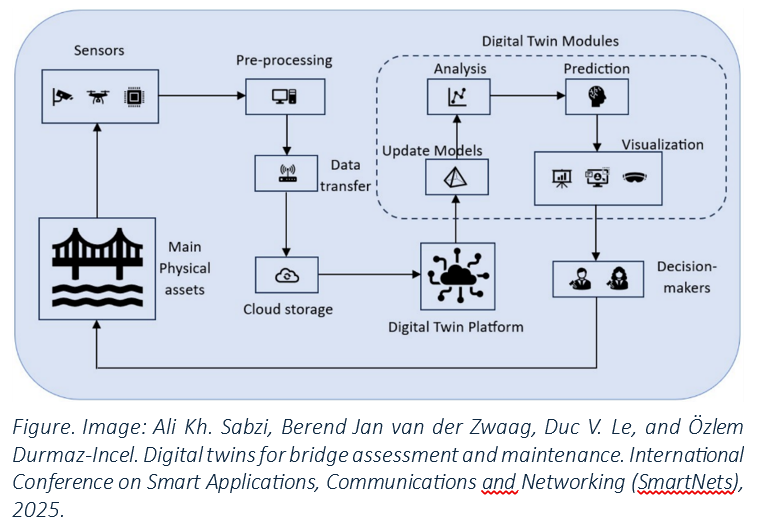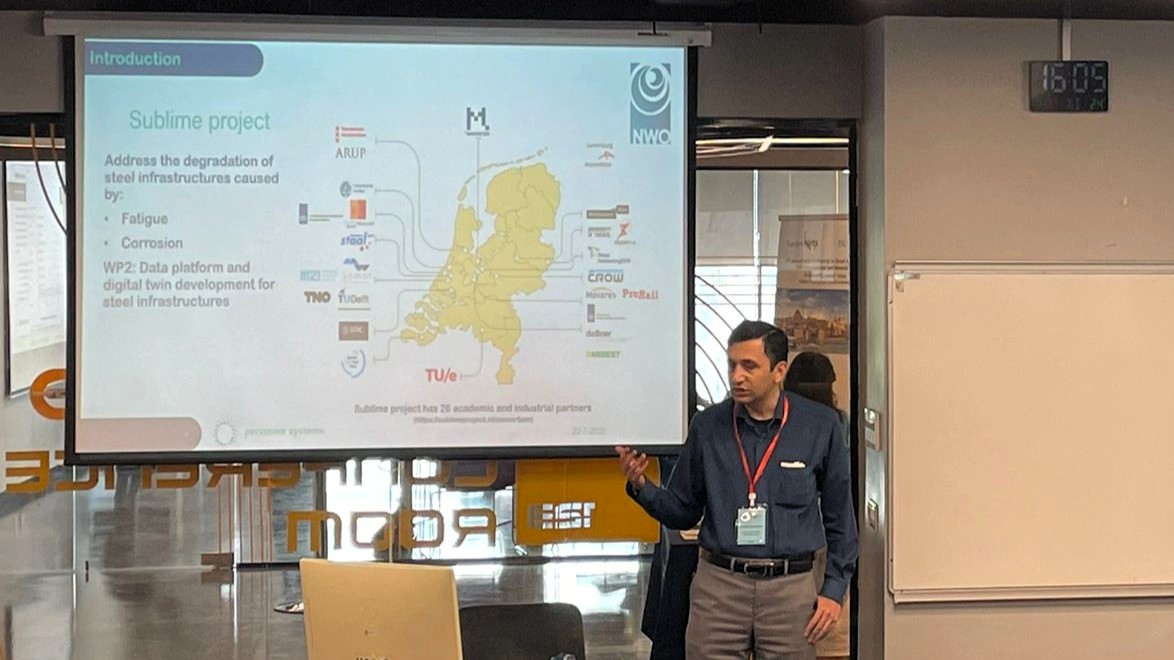Project Description
Key information
Project title: SUstainaBle and reLIable Macro stEel infra-structures (SUBLIME)
Project in the Spotlight: N21007
Market: Sustainability and Infrastructure
Written by M2i Program Manager: Viktoria Savran
 The SUBLIME consortium is proud to share that Ali Sabzi Khoshraftar, EngD researcher at the University of Twente’s Pervasive Systems Research Group, presented his latest research at the IEEE SmartNets 2025 conference. The conference took place from 22-24 July 2025 and hosted by Istinye University, Turkey, and brought together global experts in digital systems, monitoring technologies, and smart infrastructure. Ali’s paper, titled “Digital Twins for Bridge Assessment and Maintenance,” addresses a critical challenge faced by asset managers worldwide: how to efficiently and accurately monitor and maintain an aging stock of bridges in a safe, cost-effective, and environmentally conscious manner. Developed as part of Work Package 2 of the SUBLIME project, his work introduces a reference architecture for a predictive digital twin (DT) system tailored specifically for steel bridge maintenance.
The SUBLIME consortium is proud to share that Ali Sabzi Khoshraftar, EngD researcher at the University of Twente’s Pervasive Systems Research Group, presented his latest research at the IEEE SmartNets 2025 conference. The conference took place from 22-24 July 2025 and hosted by Istinye University, Turkey, and brought together global experts in digital systems, monitoring technologies, and smart infrastructure. Ali’s paper, titled “Digital Twins for Bridge Assessment and Maintenance,” addresses a critical challenge faced by asset managers worldwide: how to efficiently and accurately monitor and maintain an aging stock of bridges in a safe, cost-effective, and environmentally conscious manner. Developed as part of Work Package 2 of the SUBLIME project, his work introduces a reference architecture for a predictive digital twin (DT) system tailored specifically for steel bridge maintenance.
Bridging the Gap Between Monitoring and Prediction
As many Dutch bridges approach or exceed their intended design lifespan, traditional inspection methods—based on periodic, manual, and visual checks—are becoming increasingly inadequate. They are costly, time-consuming, prone to human error, and unable to provide the continuous insights needed for proactive maintenance planning.
The proposed digital twin system developed by Ali and his co-authors offers a transformative solution (see figure). It integrates:
- Sensor networks (e.g., accelerometers, IMUs, UAV-mounted cameras),
- Edge computing and AI-based data processing, and
- Extended and virtual reality (XR/VR) environments to support inspectors and decision-makers.
This system enables real-time condition assessment, automated defect detection, and predictive modelling of structural health. Importantly, the platform also preserves historical inspection data in digital form, supporting better-informed decisions and smoother transitions between contractors.
From Concept to Prototype: The Tankinkbrug Case Study
A key strength of the Ali’s work lies in its practical application. The research team developed and tested their prototype on the Tankinkbrug, a tied-arch steel bridge located in the Twente region of the Netherlands. The case study involved using data from a combination of fixed accelerometers and wireless IMUs on the structure, combined with drone imagery to construct a 3D model through photogrammetry. The digital twin interface—developed in C# using Unity and WPF—allows users to interact with sensor data in real time and perform remote inspections in a 3D virtual environment. This implementation demonstrates the feasibility of integrating cutting-edge sensing, AI, and immersive visualization technologies into one operational tool for asset monitoring.
Quantifying the Benefits: A 15-Year Simulation
To further validate the architecture, the team conducted a 15-year simulation in MATLAB Simulink comparing traditional manual visual inspections with digital twin-enabled assessments. Key findings include:
- A 39% improvement in inspection accuracy (measured by Mean Absolute Error),
- A reduction in the number of major repair interventions,
- And a significant decrease in inspection time, with studies showing UAV and XR-supported inspections can reduce time requirements by 50–80%.
These results underscore the potential of digital twins not only to improve maintenance planning and reduce costs but also to enhance safety, availability, and sustainability of critical infrastructures. The system supports both predictive and condition-based maintenance, key pillars of the circular economy objectives promoted by SUBLIME.
Contribution to SUBLIME and the Broader Scientific Community
This work exemplifies the central ambitions of the SUBLIME project: developing practical, scalable, and intelligent tools that extend the reliable service life of steel infrastructure, reduce material usage, and enable smarter governance.
Ali’s contribution marks an important milestone in bridging the gap between academic research and real-world implementation. His presentation at IEEE SmartNets 2025 positions the SUBLIME project at the forefront of innovation in infrastructure digitalization, strengthening its visibility within both the international research community and the industrial ecosystem.
Looking Ahead
While the current prototype has proven effective in simulation and limited deployment, the research team acknowledges the need for full-scale implementation and broader validation across multiple bridge types. Future work will focus on integrating predictive models directly into operational DT platforms and exploring the transition toward prescriptive maintenance, where AI not only monitors and predicts, but also recommends specific interventions.
As cities like Amsterdam—with thousands of bridges in active use—deal with the twin challenges of aging infrastructure and sustainability goals, digital twin systems such as the one presented by Ali Sabzi may soon become indispensable tools in the asset management toolbox.
We congratulate Ali on this achievement and look forward to sharing more insights and outcomes from his work and from the broader SUBLIME research community.



